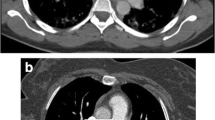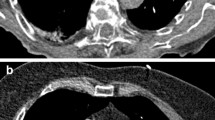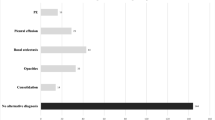Abstract
The main objective of this study was to assess the quality of CT pulmonary angiography (CTPA) for suspected pulmonary embolus (PE) in the pregnant population. We retrospectively identified 40 consecutive pregnant patients who underwent CTPA from January 2005 to December 2006. Forty consecutive age-matched non-pregnant women were used as a control group. Studies were subjectively graded according to overall image quality by two readers in consensus, in randomised and blinded manner. Moreover, contrast enhancement of pulmonary arteries was subjectively and objectively evaluated. The proportion of sub-optimal studies was more than three times higher in the pregnant group (27.5%, n = 11) compared with the non-pregnant group (7.5%, n = 3; p = 0.015). Mean contrast enhancement was consistently higher in the non-pregnant group compared with pregnant group, both subjectively and objectively. The percentage of inadequately opacified vascular segments was more than two times higher in the pregnant group (28.7%, n = 264) than in the non-pregnant group (13.3%, n = 122; p = 0.0001). The incidence of sub-optimal CTPA studies is higher in pregnancy when compared with an age-matched non-pregnant control group. In addition to radiation issues, this should also be considered when implementing diagnostic strategies for suspected PE in pregnancy.

Similar content being viewed by others
References
Toglia MR, Weg JG (1996) Venous thromboembolism during pregnancy. N Engl J Med 335:108–114
British Thoracic Society (2003) Guidelines for the management of suspected acute pulmonary embolism. Thorax 58:470–483
Stein PD, Woodard PK, Weg JG et al (2006) Diagnostic pathways in acute pulmonary embolism: recommendations of the PIOPED II investigators. Am J Med 119:1048–1055
Schuster ME, Fishman JE, Copeland JF et al (2003) Pulmonary embolism in pregnant patients: a survey of practices and policies for CT pulmonary angiography. AJR Am J Roentgenol 181:1495–1498
Scarsbrook AF, Gleeson FV (2007) Investigating suspected pulmonary embolism in pregnancy. BMJ 334:418–419
Matthews S (2006) Short communication: imaging pulmonary embolism in pregnancy: what is the most appropriate imaging protocol? Br J Radiol 79:441–444
Cook JV, Kyriou J (2005) Radiation from CT and perfusion scanning in pregnancy. BMJ 331:350
Groves AM, Yates SJ, Win T et al (2006) CT pulmonary angiography versus ventilation-perfusion scintigraphy in pregnancy: implications from a UK survey of doctors’ knowledge of radiation exposure. Radiology 240:765–770
Scarsbrook A, Bradley K, Gleeson F et al (2007) Perfusion scintigraphy still has important role in evaluation of majority of pregnant patients with suspicion of pulmonary embolism. Radiology 244:623–624 author reply 625
Baile EM, King GG, Muller NL et al (2000) Spiral computed tomography is comparable to angiography for the diagnosis of pulmonary embolism. Am J Respir Crit Care Med 161:1010–1015
Scarsbrook AF, Evans AL, Owen AR et al (2006) Diagnosis of suspected venous thromboembolic disease in pregnancy. Clin Radiol 61:1–12
Ghaye B, Szapiro D, Mastora I et al (2001) Peripheral pulmonary arteries: how far in the lung does multi-detector row spiral CT allow analysis? Radiology 219:629–636
Ryu JH, Swensen SJ, Olson EJ et al (2001) Diagnosis of pulmonary embolism with use of computed tomographic angiography. Mayo Clin Proc 76:59–65
Henk CB, Grampp S, Linnau KF et al (2003) Suspected pulmonary embolism: enhancement of pulmonary arteries at deep-inspiration CT angiography–influence of patent foramen ovale and atrial-septal defect. Radiology 226:749–755
Setty BN, Sahani DV, Ouellette-Piazzo K et al (2006) Comparison of enhancement, image quality, cost, and adverse reactions using 2 different contrast medium concentrations for routine chest CT on 16-slice MDCT. J Comput Assist Tomogr 30:818–822
Gherman RB, Goodwin TM, Leung B et al (1998) Incidence, clinical characteristics, and timing of objectively diagnosed venous thromboembolism during pregnancy. Prim Care Update Ob Gyns 5:155–156
International Commission on Radiological Protection (2000) Pregnancy and medical radiation. Ann ICRP 84:1–43
Chan WS, Ray JG, Murray S et al (2002) Suspected pulmonary embolism in pregnancy: clinical presentation, results of lung scanning, and subsequent maternal and paediatric outcomes. Arch Intern Med 162:1170–1175
Author information
Authors and Affiliations
Corresponding author
Rights and permissions
About this article
Cite this article
U-King-Im, J.M., Freeman, S.J., Boylan, T. et al. Quality of CT pulmonary angiography for suspected pulmonary embolus in pregnancy. Eur Radiol 18, 2709–2715 (2008). https://doi.org/10.1007/s00330-008-1100-0
Received:
Revised:
Accepted:
Published:
Issue Date:
DOI: https://doi.org/10.1007/s00330-008-1100-0




